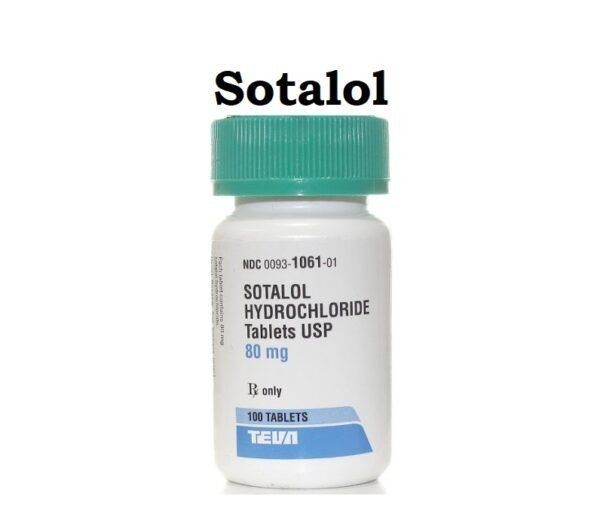
Contents
- 1 Betapace (sotalol)
- 1.0.1 Side Effects of Betapace
- 1.0.2 Dosage for Betapace
Betapace (sotalol)
Betapace is a prescription medicine used to treat arrhythmias. It may be used alone or with other medications.
Betapace belongs to a class of drugs called Antidysrhythmics, II; Antidysrhythmics, III; Beta-Blockers, Nonselective.
Side Effects of Betapace
LIFE THREATENING PROARRHYTHMIA
To minimize the risk of drug-induced arrhythmia, initiate or reinitiate oral sotalol in a facility that can provide cardiac resuscitation and continuous electrocardiographic monitoring.
Betapace can cause life-threatening ventricular tachycardia associated with QT interval prolongation.
If the QT interval prolongs to 500 msec or greater, reduce the dose, lengthen the dosing interval, or discontinue the drug.
Calculate creatinine clearance to determine appropriate dosing.
Betapace may cause serious side effects including:
- chest pain,
- fast or pounding heartbeats,
- fluttering in your chest,
- sudden dizziness,
- lightheadedness,
- slow heartbeats,
- swelling,
- rapid weight gain, and
- shortness of breath
Get medical help right away if you have any of the symptoms listed above.
The most common side effects of Betapace include:
Tell the doctor if you have any side effect that bothers you or that does not go away.
These are not all the possible side effects of Betapace. For more information, ask your doctor or pharmacist.
Call your doctor for medical advice about side effects. You may report side effects to FDA at 1-800-FDA-1088.
Dosage for Betapace
General Safety Measures For Initiation Of Oral Sotalol Therapy
- Withdraw other antiarrhythmic therapy before starting Betapace/Betapace AF and monitor carefully for a minimum of 2 to 3 plasma half-lives if the patient’s clinical condition permits.
- Hospitalize patients initiated or re-initiated on sotalol for at least 3 days or until steady-state drug levels are achieved, in a facility that can provide cardiac resuscitation and continuous electrocardiographic monitoring. Initiate oral sotalol therapy in the presence of personnel trained in the management of serious arrhythmias.
- Perform a baseline ECG to determine the QT interval and measure and normalize serum potassium and magnesium levels before initiating therapy. Measure serum creatinine and calculate an estimated creatinine clearance in order to establish the appropriate dosing interval (insert cross-ref to renal dosing). Continually monitor patients with each uptitration in dose, until they reach steady state. Determine QTc 2 to 4 hours after every dose.
- Discharge patients on sotalol therapy from an in-patient setting with an adequate supply of sotalol to allow uninterrupted therapy until the patient can fill a sotalol prescription.
- Advise patients who miss a dose to take the next dose at the usual time. Do not double the dose or shorten the dosing interval.
Adult Dose For Ventricular Arrhythmias
- The recommended initial dose is 80 mg twice daily. This dose may be increased in increments of 80 mg per day every 3 days provided the QTc < 500 msec. Continually monitor patients until steady-state blood levels are achieved.
- In most patients, a therapeutic response is obtained at a total daily dose of 160 to 320 mg/day, given in two or three divided doses.
- Oral doses as high as 480-640 mg/day have been utilized in patients with refractory life-threatening arrhythmias.
Adult Dose For Prevention Of Recurrence Of AFIB/AFL
- The recommended initial dose is 80 mg twice daily. This dose may be increased in increments of 80 mg per day every 3 days provided the QTc < 500 msec.
- Continually monitor patients until steady-state blood levels are achieved. Most patients will have a satisfactory response with 120 mg twice daily. Initiation of sotalol in patients with creatinine clearance < 40 ml/min or QTc > 450 is contraindicated.
Pediatric Dose For Ventricular Arrhythmias Or AFIB/AFL
- Use the same precautionary measures for children as you would use for adults when initiating and re-initiating sotalol treatment.
For Children Aged About 2 Years And Older
- For children aged about 2 years and older, with normal renal function, doses normalized for body surface area are appropriate for both initial and incremental dosing. Since the Class III potency in children is not very different from that in adults, reaching plasma concentrations that occur within the adult dose range is an appropriate guide.
- From pediatric pharmacokinetic data, the following is recommended:
- For initiation of treatment, 30 mg/m² three times a day (90 mg/m² total daily dose) is approximately equivalent to the initial 160 mg total daily dose for adults.
- Subsequent titration to a maximum of 60 mg/m² (approximately equivalent to the 360 mg total daily dose for adults) can then occur. Titration should be guided by clinical response, heart rate and QTc, with increased dosing being preferably carried out in-hospital.
- At least 36 hours should be allowed between dose increments to attain steady-state plasma concentrations of sotalol in patients with age-adjusted normal renal function.
For Children Aged About 2 Years Or Younger
- For children aged about 2 years or younger, the above pediatric dosage should be reduced by a factor that depends heavily upon age, as shown in the following graph, age plotted on a logarithmic scale in months.
- For a child aged 20 months, the dosing suggested for children with normal renal function aged 2 years or greater should be multiplied by about 0.97; the initial starting dose would be (30 x 0.97)=29.1 mg/m², administered three times daily.
- For a child aged 1 month, the starting dose should be multiplied by 0.68; the initial starting dose would be (30 x 0.68)=20 mg/m², administered three times daily.
- For a child aged about 1 week, the initial starting dose should be multiplied by 0.3; the starting dose would be (30 x 0.3)=9 mg/m². Use similar calculations for dose titration.
- Since the half-life of sotalol decreases with decreasing age (below about 2 years), time to steady-state will also increase. Thus, in neonates, the time to steady-state may be as long as a week or longer.
Dosage For Patients With Renal Impairment
Adults
- Use of sotalol in any age group with decreased renal function should be at lower doses or increased intervals between doses. It will take much longer to reach steady-state with any dose and/or frequency of administration. Closely monitor heart rate and QTc.
- Dose escalations in renal impairment should be done after administration of at least 5 doses at appropriate intervals (Table 1). Sotalol is partly removed by dialysis; specific advice is unavailable on dosing patients on dialysis.
- The initial dose of 80 mg and subsequent doses should be administered at the intervals listed in Table 1 or Table 2.
Table 1: Dosing Intervals for treatment of Ventricular Arrhythmias in renal impairment
| Creatinine Clearance mL/min | Dosing Interval (hours) |
| > 60 | 12 |
| 30-59 | 24 |
| 10-29 | 36-48 |
| < 10 | Dose should be individualized |
Table 2: Dosing Intervals for treatment of AFIB/AFL in renal impairment
| Creatinine Clearance mL/min | Dosing Interval (hours) |
| > 60 | 12 |
| 40-59 | 24 |
| < 40 | Contraindicated |
| Creatinine Clearance mL/min | Dosing Interval (hours) |
| > 60 | 12 |
| 40-59 | 24 |
| < 40 | Contraindicated |


